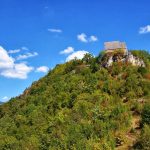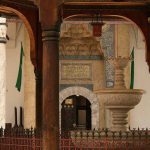Someone once said, “If something is Bosnian in Bosnia, it is Vareš.” Perhaps that is the greatest value of Vareš. But Vareš is also Zvjezdangrad (Star City), the mythical Vareš before Vareš we know today, named after the mountain with the most beautiful name – Zvijezda (Star).

There is something big and wooden in Vareš, something first and oldest, and something first of its kind, and yes, something royal.
What else can be found in this small town, which has been inhabited since ancient times and where mining and iron processing have been present since the Roman era? Besides the largest reserve of drinking water in the country, I mean?
Vareš is undeniably a tourist’s paradise, boasting a wealth of cultural and natural heritage. The locals are renowned for their hospitality, and the region offers a plethora of cultural events, such as Pekijada in Oćevija, Art Colony in Borovica, and VaClaFa. For nature enthusiasts, Via Dinarica and Zvjezdane staze (Star Trails) provide hiking and biking trails that offer both an adrenaline-fueled and calming experience in some of the most beautiful forest areas in Southeast Europe. Additionally, the Vareš region is well-known for its top-quality, organically-produced local food, including local goat cheese, trout, and Vareš honey. You will discover the rest on your own.
OLD CHRUCH
Vareš is an important center of Catholicism in Bosnia, and Old Church (Stara crkva) is the oldest surviving Catholic church in the country. The locals in Vareš refer to it as Mala (The Small One), and it is dedicated to Saint Michael. Since the 16th century, the church has stood the test of time despite several fires, including two major ones — one during the Great Turkish War in 1679 and another at the beginning of the 19th century. Despite its trials, it was reconstructed to retain its original shape and size. The walls were skillfully constructed by Herzegovinian masons and the vault by local craftsmen. Although the church is no longer used for religious purposes, it is open to the public. The VaClaFa festival is held here, and it draws a large number of classical music enthusiasts, both musicians and guests alike.
MOSQUE IN KARIĆI
According to tradition, the mosque was built by Hajdar-dedo, a scholar who accompanied Sultan Mehmed the Conqueror on his campaigns. The mosque’s hewn wood construction without nails seamlessly fits into the surrounding environment. An intriguing enigma is located in the harem, where one of the tombstones always has water in the stone, regardless of the external temperature. Legends say that these are tears of the bereaved. It is believed that the water is medicinal, so believers dip their index fingers in it and recite prayers for good health.
STONE BRIDGE
Stone Bridge (Kameni Most) tells the tragic love story of Akif and Anka. On their wedding day, Akif waited for Anka on the other side of the river, only to see her fall from a wooden bridge into the swollen river. He jumped after her and caught her hand just before he passed away. Akif’s father spent his fortune building the bridge and had it connected by builders from both sides, just as Anka’s and Akif’s hands were in their last moments. A hole was left in the bridge construction where Jusuf placed two gold rings to posthumously marry the young couple.
ORTHODOX CHURCH
The Orthodox Church, dedicated to the Protection of the Theotokos, was constructed in 1891. It was added to the list of national monuments in Bosnia and Herzegovina in 2005 and declared a national cultural monument with movable and immovable property in 2009. The church is used only occasionally and houses a valuable collection of icons.
LAKE SMREKA
Located just one kilometer from Vareš, Lake Smreka can easily be reached from the local road. With a depth of 110 meters at its deepest point, the lake is a popular spot for swimmers and fishermen alike. During the winter months of January and February, the ice on the lake can reach an impressive thickness of up to 40 cm.

FORGES IN OĆEVIJA
The village of Oćevija is the last place in Europe where iron is for- ged using traditional methods that are 800 years old and powered by water. Currently, three active black- smiths primarily produce agricultural tools, axes, hoes, horseshoes, and heavy cookware. The forges in Oćevija welcome all visitors who want to witness something that has long been extinct throughout Europe. Oćevija is located in the natural environment of the centuries-old forests of Mount Zvijezda, making it an ideal choice for a one-day visit where you can both have fun and learn something new.
VILLAGES STRICA AND ZARUĐE
Before the war, Villages Strica and Zaruđe were trailblazers in rural tourism. Visitors were drawn to the mountain air, tranquil atmosphere, serene landscape, and an array of homemade products obtained from organic farming. The villages’ elevation of one thousand meters also makes it an ideal destination for winter tourism, with amenities such as lodging, dining, a fish pond, a ski lift, and a picnic area readily available.
CAVE AND TUNNEL PONIKVA
Pećina Ponikva, located on the outskirts of Vareš, is a true treasure trove for explorers. Within its depths, you can find a bear’s skull, cave milk deposits, tools dating back to the Younger Paleolithic period, and a piece of a harpoon, all located in the uppermost part of the cave.
This cave is one of only five in the world that has a roadway passing through its entire length. The tunnel is illuminated and considered one of the most beautiful in the country. Situated in front of the tunnel is a traffic sign, the first of its kind in the world, warning drivers of the danger of bats being killed in collisions with cars. This sign has become a Vareš attraction.
The area is home to several species of bats, including the greater horseshoe bat, an endemic species in Bosnia and Herzegovina. In addition, Ponikva boasts a diverse collection of other bat species, such as the lesser horseshoe bat, the greater mouse-eared bat, the lesser mouse-eared bat, the common bent-wing bat, the serotine bat, the western barbastelle, and the Alpine long-eared bat.
BOBOVAC
And at the very end – the crown. Nothing less than royal. The medieval town of Bobovac once served as the seat of the Bosnian kings of the Kotromanić dynasty. Although only the outlines of the once imposing royal fortress remain, that does not stop tourists from visiting in search of some ancient times. With a bit imagination, you can almost hear the clinking of swords as knights fight for the favor of a beautiful court lady or the rustling of silk dresses. A favorite spot for taking pictures is the well into which Queen Katarina allegedly threw a great treasure during her escape from Bobovac – a treasure that has yet to be found.

In addition to the remains of the Bobovac walls, its surroundings are also attractive. In addition to the mysterious well, you’ll be captivated by the stunning beauty of nature and the glistening green forests whose canopies recount enchanting tales to the chilly streams. You can trek to Bobovac from Kraljeva Sutjeska or even from Vareš. The crown of your trip will be a seven-century-old testament to the brilliance and resolve of the Bosnian kings in safeguarding their kingdom.




